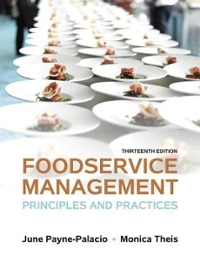Question
During lunch hours, 3 workers make salads at the front for walk-in customers, while 2 workers fulfill online orders in the back. Each salad takes
During lunch hours, 3 workers make salads at the front for walk-in customers, while 2 workers fulfill online orders in the back. Each salad takes an average of 4 minutes to prepare, and the standard deviation of this preparation time is 3 minutes. (The preparation times for walk-in and online orders have the same distribution.) The interarrival time for walk-in customers is 1.5 minutes on average, and the average interarrival time for online orders is 3 minutes. Assume that customers and online orders arrive randomly, such that the coefficient of variation of the interarrival times is 1 for both lines.
(a) How many minutes on average does a customer need to wait in line, if the customer walks into the store to order a salad in person?
(b) If the customer places an order online instead, how many minutes does it take for the customer to get the salad, after the customer placed the order? Note that this includes both (i) the time the order waits "in line" and (ii) the time it takes for a worker to prepare the order.
(c) The store is considering redesigning its work flow again, merging the two salad production lines into a single line, and have all 5 workers prepare walk-in and online orders in a first-come-first-serve manner. If this change is implemented, what is the new waiting time?
Hint: Once the two production likes are merged, the average interarrival time for orders (walk-in and online combined) will be 1 minute. This is because:
The interarrival time for walk-in customers is 1.5 mins, meaning that in each hour, 60/1.5=40 walk-in orders arrive.
The interarrival time for online orders is 3 mins, meaning that in each hour, 60/3=20 online orders arrive.
In total, 40+20 = 60 orders arrive in each hour, thus the new average interarrival time is 60/60 = 1 minute. Assume that the coefficient of variation of the new interarrival times is 1.
(d) In addition to the average waiting times, what other factors should the store consider when making the decision on whether to merge the two salad production lines? What do you think are the pros and cons?
Step by Step Solution
There are 3 Steps involved in it
Step: 1

Get Instant Access to Expert-Tailored Solutions
See step-by-step solutions with expert insights and AI powered tools for academic success
Step: 2

Step: 3

Ace Your Homework with AI
Get the answers you need in no time with our AI-driven, step-by-step assistance
Get Started


